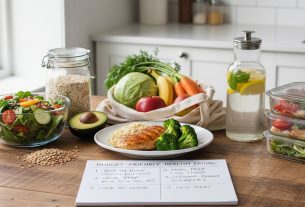Estimated Reading Time: 8 minutes
Estimated Reading Time: 7 minutes
RRmember the days when “healthy eating” sounded like a luxury reserved for the well-heeled? I do!
Back then, I pictured organic farmers’markets and exotic imported produce.
Reality hit hard when I realized I was living on instant noodles and the cheapest processed food I could find.
It wasn’t sustainable – both for my wallet and my well-being.
But I learned, the hard way, that delicious and nutritious meals don’t require a trust fund.
It’s all about knowing how to shop, how to cook, and how to plan.
This isn’t just about cutting costs; it’s about making smart choices that fuel your body and support your health without breaking the bank.
We’re going to delve into some budget-friendly healthy eating tips that are practical, achievable, and, dare I say, enjoyable.
Where does one even begin? Planning!
It may seem like a chore, but planning your meals is the single most impactful thing you can do to eat healthily on a budget.
Without a roadmap, you’re lost in the grocery store, and those impulse buys of expensive ready-made meals will become the norm. Trust me, I know.
This is where budget-friendly healthy eating tips truly begin to take shape.
First, take stock of what you already have. Raid your pantry, check the fridge, and assess what needs to be used up.
Next, browse sales flyers and create a meal plan centered around what’s on offer. Focus on a few core ingredients that can be used in multiple ways.
For instance, roasted chicken can become a taco filling one night, chicken salad the next day, and a base for a hearty soup the following evening.
This minimizes food waste (another huge money saver!) and keeps things interesting.
Shopping without a list is like sailing without a compass; you’re likely to get lost and end up somewhere you didn’t intend.
Your grocery list is your best friend in the quest for budget-friendly healthy eating tips. Stick to it!
The aisles are designed to tempt you, so stay focused on your list. It’s also a good idea to eat before you shop.
A hungry shopper makes impulsive decisions that will almost certainly add to your bill.
Think of your list as a shield against temptation and an investment in your financial and physical wellbeing.
Armed with your meal plan and your list, it’s time to hit the stores. But where?
This is where you’ll find more budget-friendly healthy eating tips, some of which may surprise you. Consider the following.
Buying in bulk *can* be a great way to save money, especially for staples like rice, beans, oats, and spices. However, assess your needs first.
Do you have the storage space? Will you actually use the entire bulk purchase before it goes bad?
For perishables, stick to smaller quantities unless you’re confident you can incorporate them into your meal plan.
For non-perishables, though, like dried beans or grains, it can make a real difference to your grocery bill.
The difference between buying a small bag of rice and a larger one can amount to a significant saving over time.
The freezer is your ally. Embrace it! Freezing is a fantastic technique for reducing food waste and making the most of seasonal produce.
You can freeze cooked meals, individual portions of soup, chopped vegetables, and even fruit for smoothies.
Consider buying frozen fruits and vegetables – they are often more affordable than fresh and retain their nutritional value.
Another of the many budget-friendly healthy eating tips.
Protein is essential, but it doesn’t have to be expensive.
Chicken thighs (often cheaper than breasts), eggs, beans, lentils, and tofu are all excellent and inexpensive sources of protein.
Don’t underestimate the power of a good bean dish! A well-seasoned lentil soup can be incredibly satisfying and packed with nutrients.
Fresh produce is wonderful, but it can be a budget killer. Here are a few ideas for some budget-friendly healthy eating tips.
Focus on seasonal fruits and vegetables. They’re usually cheaper and taste better. Consider frozen options. They’re often just as nutritious.
Embrace versatility. A head of cabbage can be used in slaw, stir-fries, and even soups. Don’t be afraid of ugly produce!
Often, the misshapen or slightly bruised items are discounted but just as nutritious and delicious. They’re perfect for soups, stews, and smoothies.
Eating out, or relying on takeout, is one of the biggest drains on your budget and your health.
Cooking at home gives you complete control over your ingredients, portion sizes, and cooking methods. It’s also a skill worth investing in!
The more you practice, the faster and more efficient you’ll become.
Dedicate a few hours each weekend to meal prepping.
This doesn’t have to be elaborate; it can be as simple as chopping vegetables, cooking grains, or preparing a large batch of a simple dish like quinoa or brown rice, which can be used as a base for several meals.
Having ready-to-go components makes it much easier to whip up healthy meals during the busy week.
I often spend Sunday afternoon making a big batch of lentil soup, which I can freeze in individual portions and then take for lunch all week.
Leftovers are your friend! They save you time, reduce food waste, and often taste even better the next day. Repurpose leftovers into different meals.
Roast chicken from Sunday dinner? Make chicken salad sandwiches for lunch on Monday. Chili from Tuesday night?
A perfect topping for baked potatoes on Wednesday. Embrace the potential for creativity. These are true budget-friendly healthy eating tips.
You don’t need to be a gourmet chef, but knowing a few basic cooking techniques can open up a world of possibilities and make healthy cooking more enjoyable.
Learn how to roast vegetables, cook grains, and make a simple sauce or dressing.
Experiment with different herbs and spices to add flavor and excitement to your dishes.
Eating healthy on a budget isn’t about deprivation; it’s about making smart choices, planning ahead, and embracing the joy of cooking.
It’s about realizing that nourishing your body doesn’t require a king’s ransom.
By implementing these budget-friendly healthy eating tips, you can transform your health and your finances simultaneously.
It requires some adjustments at first, but the rewards of increased energy, improved health, and a lighter wallet are well worth the effort.
The best part? You can do it. Start with one tip, experiment in the kitchen, and, most importantly, enjoy the journey!
I hope these budget-friendly healthy eating tips are helpful and provide value for you. Remember, it’s a marathon, not a sprint.
Small changes, consistently implemented, will lead to big results.
So go forth, embrace the deliciousness of home-cooked meals, and enjoy the journey to a healthier, wealthier you!
Ready for more health tips? Join our newsletter for weekly health tips!
Frequently Asked Questions
What are some of the most cost-effective protein sources?
Chicken thighs, eggs, beans, lentils, and tofu are all excellent and affordable sources of protein. Chicken thighs, for example, are often cheaper than chicken breasts but just as versatile. Eggs are a nutritional powerhouse and incredibly affordable. Beans and lentils are packed with fiber and nutrients, and dried varieties are very economical. Tofu, made from soybeans, is another plant-based protein source that can be purchased relatively inexpensively.
How can I reduce food waste to save money?
Planning your meals, storing food properly, and repurposing leftovers are key strategies. Start by creating a meal plan and a corresponding shopping list, so you only buy what you need. Store food correctly, using airtight containers and proper refrigeration techniques to extend shelf life. Embrace leftovers by repurposing them into different meals. If you have vegetables that are on their way out, consider using them in soups or stocks. Also, don’t be afraid of ugly produce; it’s often cheaper and still nutritious.
Are frozen fruits and vegetables as nutritious as fresh?
Yes, frozen fruits and vegetables are often just as nutritious as fresh, and sometimes even more so. They are typically flash-frozen at their peak ripeness, which helps to preserve their nutrients. In some cases, frozen produce may even retain more nutrients than fresh produce that has been transported and stored for several days. Buying frozen options can also save you money and reduce food waste, since you can use only what you need.
What are some basic cooking techniques that can help me eat healthier on a budget?
Learning how to roast vegetables, cook grains, and make simple sauces or dressings are excellent starting points. Roasting vegetables brings out their natural sweetness and adds flavor. Knowing how to cook grains like rice, quinoa, and barley allows you to create a base for many healthy meals. Making simple sauces or dressings, such as a vinaigrette, allows you to control the ingredients and avoid added sugars and unhealthy fats found in many store-bought options. Start small and build your skills over time. Experimenting with different herbs and spices will also greatly enhance the taste of your meals.




